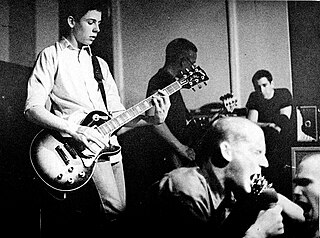History
Predecessors

In the early 1980s, hardcore punk quickly spread with the emergence of bands like Black Flag, Minor Threat, and the Dead Kennedys. [19] When Washington D.C. hardcore punk band the Bad Brains moved to New York, the New York hardcore scene was kickstarted. As the scene progressed many bands began to emerge that took significant influence from heavy metal and hip hop. Some musicians in the New York hardcore scene cultivated a "tough guy ethos" through use of criminal violence and bigotry. [20] For some bands, particularly the Cro-Mags there was an active effort to search out musicians who bore this ethos. [21] This was prominent enough within the band's sound that AllMusic writer Patrick Kennedy called their 1986 debut album the Age of Quarrel the "finest hour... [of] tough-guy hardcore". [22] While this led to widespread criticism from other hardcore scenes of the time, many of these bands began to develop a unique style that was based more around rhythm and less around the influence of punk. [20]
Beatdown's origins are particularly tied to the Lower East Side hardcore crew DMS (Doc Marten Skinheads). [9] Formed in the early 1980s by Jere DMS, the crew's embrace of elements of hardcore, hip-hop, graffiti, motorcycle, skinhead and skateboarding culture, and multi-ethnic membership led to it including members who would go on to form bands including Bulldoze, Madball and Skarhead. The way in which DMS bands would sometimes discuss their crew's brotherhood and criminal activities would play a key role in developing the lyrical themes of beatdown. [10]
One of the most prominent precursors of the genre was the Yonkers, New York band Breakdown. Formed in 1987, they were a part of a new wave of New York hardcore bands similarly expanding the scope of the genre, like Sick of It All, Sheer Terror and Krakdown. [23] The same year Judge released their debut EP New York Crew, which Crack magazine described as the record that took New York's "tough guy mentality to new heights". [24] Killing Time's 1989 debut album Brightside was a key step in New York, by making use of the heaviness of thrash metal while sidelining metal's camp and creating beatdown style groove parts in songs like "New Release". Furthermore, Madball's emphasis on heavy grooves and lack of reliance on the speed which defined earlier hardcore, became the characterizing sound of New York hardcore in the 1990s and birthed beatdown. [25] The band were credited by Riverfront Times as the band that defined tough guy hardcore. [26] In his book The Music Sound, academic Nicolae Sfetcu credited Madball's street life lyrics, Judge's syncopated, rhythmic riffing style and Biohazard's embrace of metal and hip hop as well as bands such as Killing Time, Carnivore, Maximum Penalty and Sheer Terror as the key elements which birthed the beatdown genre. [5]
Origins (mid-1990s)
Beatdown was pioneered by Bulldoze, with their 1996 album The Final Beatdown giving the genre its name. [27] [28] Bulldoze, along with Terror Zone, merged the sound of earlier New York hardcore with lyrics of gang activity and heavy breakdowns to set the template for the genre. [29] In their wake followed groups like Next Step Up, Neglect, Confusion and Grimlock. [30] The genre took a particular hold on the New Jersey hardcore scene at the time, with venues including Melody Bar, the Stone Pony and Birch Hill Nightclub frequently playing host to bands like Clubber Lang, Signed with Hate and Force of Aggression. NoEcho writer Chris Suffer called New Jersey beatdown band Shattered Realm's 2002 album " Broken Ties... Spoken Lies "the standard for which all future beatdown style hardcore should try to live up to but not expect to come anywhere close". [31]
In the following years beatdown's ignorant take on heavy riffing would prove particularly influential on the sound of nu metal. [16] Furthermore, Hatebreed formed in Bridgeport, Connecticut in 1994, merging classic hardcore with beatdown and metalcore. [32] Their 1997 debut album Satisfaction is the Death of Desire sold over 150,000 copies. [33] By the beginning of the 2000s the genre was declining in popularity, with the dominant style of hardcore become more metallic and noiser groups, particularly those signed to Victory Records. [34]
Recent years (2010s–present)
As the genre progressed, it became increasingly influenced by metal, often death metal and doom metal, an aspect particularly prominent in groups like Kruelty, Xibalba and No Zodiac. [17] Beatdown band Sunami formed in 2019, originally a parody of the genre's violent ignorance, the attention the band received during the COVID-19 lockdowns, particularly on TikTok , led to them selling out the majority of their live performances in the following years. A 2023 article by Revolver credited them as "in the upper echelon of bands dominating the hardcore zeitgeist". [35] [36]






